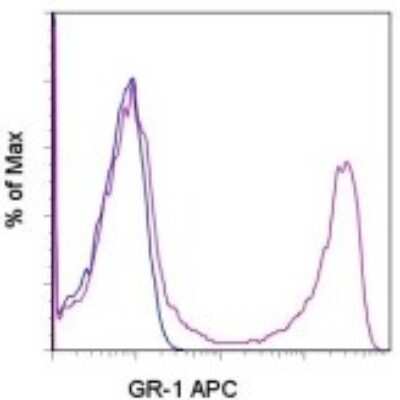Ly-6G/Ly-6C Antibody (RB6-8C5) [Allophycocyanin]
Novus Biologicals, part of Bio-Techne | Catalog # NBP2-00372


Conjugate
Catalog #
Key Product Details
Species Reactivity
Mouse
Applications
Flow Cytometry
Label
Allophycocyanin (Excitation = 620-650 nm, Emission = 660-670 nm)
Antibody Source
Monoclonal Rat IgG2b Kappa Clone # RB6-8C5
Concentration
0.2 mg/ml
Product Specifications
Immunogen
Normal mouse bone marrow.
Specificity
Studies indicate that in the bone marrow and lysed whole blood, the antibody clone RB6-8C5 also reacts with an additional subpopulation of Ly-6C high cells.
Clonality
Monoclonal
Host
Rat
Isotype
IgG2b Kappa
Scientific Data Images for Ly-6G/Ly-6C Antibody (RB6-8C5) [Allophycocyanin]
Flow Cytometry: Ly-6G Antibody (RB6-8C5) [Allophycocyanin] [NBP2-00372] - Staining of C57BL/6 bone marrow cells with 0.125 ug of Rat IgG2b kappa Isotype Control APC (blue histogram) or 0.125 ug of Anti-Mouse Ly-6G (Gr-1) APC (purple histogram). Total viable cells were used for analysis.
Applications for Ly-6G/Ly-6C Antibody (RB6-8C5) [Allophycocyanin]
Application
Recommended Usage
Flow Cytometry
1:10-1:1000
Application Notes
The RB6-8C5 antibody has been tested by flow cytometric analysis of mouse bone marrow cells and splenocyte suspensions. This can be used at less than or equal to 0.5 ug per test. A test is defined as the amount (ug) of antibody that will stain a cell sample in a final volume of 100 uL. Cell number should be determined empirically but can range from 10^5 to 10^8 cells/test. The RB6-8C5 antibody has also been reported for use immunoprecipitation, immunoblotting (WB) and immunohistochemical staining. It is recommended that the antibody be carefully titrated for optimal performance in the assay of interest. In vivo assay was reported in scientific literature.
Formulation, Preparation, and Storage
Purification
Protein A or G purified
Formulation
PBS
Preservative
0.05% Sodium Azide
Concentration
0.2 mg/ml
Shipping
The product is shipped with polar packs. Upon receipt, store it immediately at the temperature recommended below.
Stability & Storage
Store at 4C. Do not freeze.
Background: Ly-6G (Gr-1)
Expression of Ly-6G and Ly-6C, along with other lineage markers, help define specific cell types (2,4). For example, mouse myeloid derived suppressor cells (MDSCs), which play a role in inflammation and tumor development, are further subdivided into granulocytic (G-MDSCs) or monocytic (Mo-MDSCs) (4). Mo-MDSCs express Ly-6Chi along with CD11b, but are negative for Ly-6G, whereas G-MDSCs express Ly-6Clo/int,Ly-6Ghi , and CD11b (4).
The monoclonal antibody RB6-8C5 first identified granulocyte-differentiation antigen (Gr-1) which is primarily expressed on the surface of neutrophils and immature myeloid cells, and to a lesser extent on lymphocytes and macrophages (1). Gr-1 expression increases as neutrophils mature but remains is stably expressed in monocytes (1). The RB6-8C5 reacts with both Ly-6G and Ly-6C, whereas 1A8 antibody is specific for Ly-6G (1). Antibodies against Ly-6G, such as RB6-8C5 and 1A8, are commonly used to identify a role for neutrophils in mouse models of disease as they are efficient for quickly depleting neutrophils (1). RB6-8C5, however, also targets and depletes Ly-6Chi monocytes in addition to other Ly-6G-expressing cells (1).
References
1. Lee, P. Y., Wang, J. X., Parisini, E., Dascher, C. C., & Nigrovic, P. A. (2013). Ly6 family proteins in neutrophil biology. Journal of leukocyte biology. https://doi.org/10.1189/jlb.0113014
2. Bamezai A. (2004). Mouse Ly-6 proteins and their extended family: markers of cell differentiation and regulators of cell signaling. Archivum immunologiae et therapiae experimentalis.
3. Loughner, C. L., Bruford, E. A., McAndrews, M. S., Delp, E. E., Swamynathan, S., & Swamynathan, S. K. (2016). Organization, evolution and functions of the human and mouse Ly6/uPAR family genes. Human genomics. https://doi.org/10.1186/s40246-016-0074-2
4. Kong, Y. Y., Fuchsberger, M., Xiang, S. D., Apostolopoulos, V., & Plebanski, M. (2013). Myeloid derived suppressor cells and their role in diseases. Current medicinal chemistry. https://doi.org/10.2174/0929867311320110006
Long Name
A Myeloid Differentiation Antigen
Alternate Names
Gr-1
Gene Symbol
LY6G
Additional Ly-6G (Gr-1) Products
Product Documents for Ly-6G/Ly-6C Antibody (RB6-8C5) [Allophycocyanin]
Product Specific Notices for Ly-6G/Ly-6C Antibody (RB6-8C5) [Allophycocyanin]
This product is for research use only and is not approved for use in humans or in clinical diagnosis. Primary Antibodies are guaranteed for 1 year from date of receipt.
